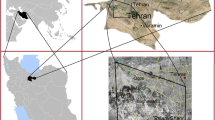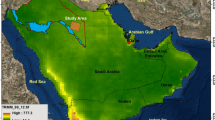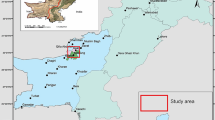Abstract
Increase in urban development activities and urbanization rate in the Bandung Basin have increased groundwater extraction from the aquifers, which has then led to land subsidence in several locations in the basin. Based on GPS (Global Positioning System) and InSAR (Interferometry Syntetic Aperture Radar) data, the estimated subsidence rates vary spatially from 2 to 20 cm/year. Maximum subsidence during the period of 1999–2010 is about 3 m and largest in industrial areas. Site visit surveys were also conducted to map and evaluate the impacts of the land subsidence.
Based on the site visit surveys, the impacts of land subsidence can be seen in several forms such as cracks in buildings, damage of infrastructure (road and bridges), tilting and damaged houses, and change in the flooding inundation area. Flooding frequently occurs in the area where the subsidence rate is high. For example, the 2010 heavy flooding covered the areas where the subsidence is about 7–10 cm/year. This suggests that land subsidence aggravates the flooding hazard in the Bandung Basin.
Access provided by Autonomous University of Puebla. Download conference paper PDF
Similar content being viewed by others
Keywords
1 Introduction
The Bandung Basin is a large intra-montane basin surrounded by volcanic highlands, located in West Java province, Indonesia (Fig. 1). “The central part of the basin has an altitude of about 665 m and is surrounded by up to 2,400-m-high Late Tertiary and Quaternary volcanic terrain (Dam et al. 1996)”. The catchment area of the basin and surrounding mountains covers approximately 2,300 km2, and the Citarum River with its tributaries forms the main drainage system of the basin catchment. It is one of the largest watersheds on the island of Java, and provides water for drinking, agriculture and fisheries, as well as the main supply for three reservoirs (hydroelectric dams), with a total volume of about 6,147 million m3 (Wangsaatmaja et al. 2006). Mean annual temperature in the basin is about 23.7 °C and mean annual precipitation amounts to about 1,700 mm (Iwaco-Waseco 1991). Deposits in the basin comprise of coarse volcaniclastics, fluvial sediments and notably a thick series of lacustrine deposits.
On the basis of its hydraulic characteristics and its depth, the multi-layer aquifer configuration of the Bandung Basin may be simplified into two systems (Soetrisno 1996): shallow aquifers (a few metres to around 40 m below the surface) and deep aquifers (more than 40–250 m below the surface). These aquifers are composed of volcanic products from the volcanic complexes that bordered this basin, and lake sediments that were deposited when the central part of the basin was a lake. The lake was fully formed about 50,000~years ago, and was drained away about 16,000 years ago (Dam et al. 1996).
The population of the Bandung municipality increased from less than 40,000 in 1906 to nearly one million in 1961, and had grown to about two and half million by 1995. The population in the whole Bandung Basin was about 3.4 million in 1986, became about 4.4 million in 1994, was about 5.9 million people in 2003, and in 2005 more than seven million people inhabited the basin (Abidin et al. 2011). The increase in both population and industrial activity in turn increased the degree of groundwater withdrawal from the aquifers in the Bandung Basin. Increased groundwater extraction has led to a rapid lowering of water table on the plain.
The groundwater extraction is expected to cause land subsidence in the Bandung Basin in addition to subsidence induced by the load of manmade constructions (i.e. settlement of highly compressible soil), subsidence caused by natural consolidation of alluvium soil, and geotectonic subsidence (Abidin et al. 2011).
The impacts of land subsidence can be seen in several forms, such as cracks in buildings, damage of infrastructures (road and bridges), tilting and damaged houses, and increases in the flooding inundation area. Flooding in Bandung Basin occurs many times in a year and heavy flooding usually happens after heavy rainfall. Flooding in Bandung Basin has caused huge economic losses to households, businees, industry, agriculture, infrastructure, public facilities and social activities in the affected area.
2 Land Subsidence Derived by GPS Dan InSAR Methods in Bandung Basin
Several methods have been conducted to monitor land subsidence in the Bandung Basin, such as GPS (Global Positioning System) surveys and InSAR (Inteferometry Syntetic Aperture Radar) (Abidin et al. 2008).
In order to study land subsidence in the Bandung Basin, eight GPS surveys were conducted in 21–24 February 2000, 21–30 November 2001, 11–14 July 2002, 1–3 June 2003, 24–27 June 2005, 21–23 August 2008, 26–29 July 2009, and 29–31 July 2010 by the the Geodesy Research Division, Institute of Technology Bandung (ITB). Distribution of observed sites can be seen in Fig. 2.
Surveys at all stations were carried out using dual-frequency geodetic-type GPS receivers. In this case the PSCA station was used as the reference point with known coordinates and it was assumed to be stable. The data were processed using the software Bernese 5.0 (Beutler et al. 2007). Since we are mostly interested in the relative heights with respect to a stable point, the radial processing mode was used instead of a network adjustment mode. In this case, the relative ellipsoidal heights of all stations are determined relative to PSCA. For the data processing, a final precise ephemeris (SP3) was used. The effects of tropospheric and ionospheric biases are reduced by the differencing process and the use of dual-frequency observations. The residual tropospheric bias parameters for individual stations are estimated to further reduce the tropospheric effects. The algorithms for the tropospheric parameter estimation can be found in Beutler et al. (2007). In processing of GPS phase observations, GPS phase ambiguities were successfully resolved. Results of the GPS data processing for several stations can be seen in Fig. 3.
The GPS results for the last campaign can be seen in Fig. 4. The Kriging method was applied to generate the contour of subsidence in the Bandung Basin.
The pattern of land subsidence from 2008 to 2009 and 2009 to 2010 is almost the same. The biggest land subsidence occured in Cimahi, Dayeuhkolot, Gedebage, Majalaya, and Rancaekek, all of which are industrial areas. Maximum rate of land subsidence 2009–2010 was 15 cm/year.
We have also analyzed InSAR data in the Bandung Basin from the ALOS/PALSAR satellite. All the data were processed by the Gamma software. We used dual-pass differential method to produce the deformation image in Bandung Basin. Dual-pass DInSAR (Differential InSAR) needs only twoSAR images and the DEM to produce the deformation image. In this research, Alos/Palsar data (on 3 June 2006, 6 March 2007, 14 January 2007, 18 April 2009, 28 January 2009, and 3 May 2010) were used and the DEM data is from SRTM (Shuttle Radar Topography Mission) 90 m × 90 m.
InSAR result for the last 2 years can be seen in Fig. 5.
Based on InSAR results in Fig. 4, the subsidence from January 2009 to December 2009 is as large as 20 cm, while from December 2009 to May 2010, it is as large as10–12 cm. We assume that all motion observed from InSAR results are due to vertical motion. Comparing to the GPS result (Fig. 3), the InSAR derived subsidence rate is larger than that of GPS. It should be noted that the subsidence rate derived from InSAR is still affected by noise due to phase unwrapping and very low correlation of images, quality of DEM, and atmospheric effect. Regardless of noise effect in InSAR data, the results show that large subsidence seems to occurs at Cimahi, Dayeuhkolot, Rancaekek, and Gedebage. Since the InSAR-based subsidence rate is derived from the line of sight observations, not from the difference of two vertical heights, it would be of advantage to combine InSAR and GPS observations.
GPS provides better accuracy results than that of InSAR, however, InSAR provides better spatial resolution than GPS. Therefore integration of GPS and InSAR method provides a better solution to obtain high accuracy and wide spatial information of land subsidence. In this research, we model the subsidence by assimilating the result from the GPS and InSAR data. The combine technique used in Karabatic (2011) for the case of water vapour assimilation is adopted.
In the weighting method, to obtain the integrated value of land subsidence (LS) at each point of the model grid the, LS from the InSAR are multiplied with the \( {f_{ij }} \) coeficients for each grid point \( i,j \):
To calculate the coefficients \( {f_{ij }} \), the following function has been applied:
The coefficients are weighted with respect to distance \( r \) of the GPS station \( k \) (\( {r_k} \)) to the grid point using the following weighting function:
\( {r_l} \) represent the distance of all relevant stations, i.e. the ones within 15 km (denoted with l). The multipliers \( fk \) for each of the GPS stations are calculated using following expression:
Where \( L{S^{GPS\ }} \) represent land subsidence derived from GPS observations and \( L{S^{InSAR }} \) represents land subsidence derived from InSAR data, and \( \theta\ and\ \emptyset \) are longitude and latitude of station \( k \), respectiveliy. The weighting result can be seen in Fig. 6.
Based on combination result of GPS and InSAR, land subsidence in Bandung Basin reached 3 m from 1999 until 2010. It should be noted that InSAR results were extrapolated to 1999 by assuming that subsidence rate varies linearly with time. The largest subsidence occurred in Cimahi, Gedebage, Dayeuhkolot, Rancaekek, Majalaya and Leuwigajah.
The areas of large subsidence are industrial areas which is expected because they draw large amounts of water out of deep aquifer. The industry relies 100 % on groundwater resources. The land subsidence in these area has impacts such as cracks on buildings, damaged houses, cracks on roads/highways, and an expansion of flooding area.
3 Groundwater Extraction in Bandung Basin
Increase in both population and industrial activity has increased the degree of groundwater withdrawal from the aquifers in the Bandung Basin, as illustrated in Fig. 7. According to Wirakusumah (2006), about 60 % of the total clean water required in the Greater Bandung Area (i.e. about 512 million m3) is supplied by groundwater, and industry relies nearly 100 % on groundwater resourches. The two primary categories of groundwater withdrawers in the basin are shallow well pumps and deep well pumps. The majority of shallow wells are used for domestic purposes, while deep wells are operated by the regional water company or by private firms such as textile industries, manufacturing companies and hotels (Braadbaart and Braadbaart 1997).
Figure 8 show the lowering of the groundwater table from the deep aquifer in some factory wells in Bandung Basin. Nearly 50 % of these industries are the textile industries which require large amount of water for their textile processing process. Since many of them are located in the areas with no piping infrastructure, the use of groundwater becomes a cheap and attractive solution for these industries.
Land subsidence and groundwater extraction can be correlated by utilizing the registered groundwater extraction volume and the observed groundwater level. In case of the correlation with groundwater extraction, Abidin et al. (2006, 2008) have shown that the GPS-derived land subsidence do not always have a positive correlation with the registered volume of groundwater extraction around the corresponding GPS stations (i.e. inside 1 km radius). This fact could imply two things: first, the registered groundwater extraction volume does not reflect the real groundwater use, and second the amount of land subsidence is also influenced by other factors, such as geological structures and soil compressibility at the observed locations. In some wells, there is strong correlation between land subsidence and decrease of groundwater table as shown in Fig. 9.
4 Impact of Land Subsidence in Bandung Basin
In general, the impacts of land subsidence in Bandung Basin could be seen in several forms, such as cracking of permanent constructions and roads, changes in river canal and drain flow systems, tilting and damaged houses, wider expansion of flooding areas, and malfunction of drainage system. Field survey have been conducted to identify such impacts and the result can be seen in Fig. 10.
All impacts are direct impact of land subsidence and it makes some potential economic losses for household and for local government. Cracking on the building and road/highway occurs not in the large subsidence area but in the boundary of large subsidence area and the less. Damaged on houses and road occurs in large subsidence area.
The indirect effects of subsidence through aggravation of other hazards already present in the area that are frequently more severe than the direct effects (Viets 2010). In Bandung Basin, the increase in flooding caused by continuing subsidence introduce more problems compared to other indirect effects of land subsidence. The flooding mainly occurred in the areas along the Citarum River and its tributaries because water cannot penetrate the ground quick enough; and subsidence in these areas will worsen it. Figure 11 shown flooding area 2010 in Bandung Basin overlaid with land subsidence.
Flooding in the areas which have relatively large subsidence in Bandung Basin are shown in Fig. 11, namely Gedebage, Majalaya, Rancaekek, and Dayeuh Kolot. Figure 10 shows the flooded areas in 2010 in comparison with their land subsidence rates; Gedebage closes to GPS station of GDBG; Majalaya closes to GPS stations of MJL2 and NP02; Rancaekek closes to GPS stations of RCK1 and 2430; and Dayeuhkolot closes to GPS station of M13L (Abidin et al. 2011).
5 Discussion and Conclusion
Based on the result obtained from land subsidence monitoring in the Bandung Basin, it can be concluded that a combination of GPS survey and InSAR result are useful for studying and monitoring land subsidence in Bandung Basin. According to our visual observation, we found that results from the combination of GPS and InSAR are more realistic than the results from each method alone. Several places such as Dayeuhkolot, Gedebage, Banjaran, Majalaya, and Cimahi has higher subsidence rate compared to others.
In the case of land subsidence in the Bandung Basin, excessive groundwater extraction is one’s of main cause of land subsidence. Further research is still needed to clarify the real mechanism and pattern of land subsidence in the Bandung Basin
Based on field survey, land subsidence in Bandung Basin has an impact such as: the wider expansion flooding areas and damages (cracking) of buildings/infrastructure that potential cause economic losses. This result can be of importance for the government to propose an optimal regulation of the groundwater extraction in the Bandung Basin.
References
Abidin HZ, Andreas H, Gamal M, Djaja R, Murdohardono D, Rajiyowiryono H, Hendrasto M (2006) Studying landsubsidence of Bandung Basin (Indonesia) using GPS survey method. Surv Rev 38(299):397–405
Abidin HZ, Andreas H, Gamal M, Wirakusumah AD, Darmawan D, Deguchi T, Maruyama Y (2008) Land subsidence characteristics of the Bandung Basin, Indonesia, as estimated from GPS and InSAR. J Appl Geod 2(3):167–177. doi:10.1515/JAG.2008.019
Abidin HZ, Gumilar I, Andreas H, Sidiq TP, Fukuda (2011). Study on causes and impacts of land subsidence in Bandung Basin, Indonesia. Paper presented in FIG working week 2011, bridging the gap between cultures, Marrakech, Marocco, 18–22 May 2011
Beutler G, Bock H, Dach R, Fridez P, Gade A, Hugentobler U, Jaggi A, Meindl M, Mervant L, Prange L, Schaer S, Springer T, Urschl C, Walser P (2007) In: Dach R, Hugentobler U, Fridez P, Meindl M (eds) Bernese GPS software version 5.0. Astronomical Institute, University of Berne, Berne, p 612
Braadbaart O, Braadbaart F (1997) Policing the urban pumping race: industrial groundwater overexploitation in Indonesia. World Dev 25(2):199–210
Dam MAC, Suparan P, Nossin JJ, Voskuil RPGA, G. T. L.Group (1996) A chronology for geomorphological developments in the greater Bandung area, West-Java, Indonesia. J Southeast Asian Earth Sci 14(1–2):101–115
Iwaco-Waseco (1991) Bandung hydrological study. Main Report Annex 1: surface water resources
Karabatic Anna (2011) Precise Point Positioning (PPP)—an alternative technique for ground base GNSS troposphere monitoring. Dissertation, Technisce Universitat Wien, Vienna
Soetrisno S (1996) Impact of urban and industrial development on groundwater, Bandung, West Java, Indonesia. Paper presented at the Symposium on groundwater and landuse planning, Fremantle, Western Australia, 16–18 September 1996
Viets VF (2010) Environmental and economic effects of subsidence. LBNL Paper LBL-8615, Lawrence Berkeley National Laboratory. Available at http://escholarship.org/uc/item/1sb4c8vh
Wangsaatmaja S, Sutadian AD, Prasetiati MAN (2006) A review of groundwater issues in the Bandung Basin, Indonesia: management and recommendations. Int Rev Environ Strat 6(2). http://www.iges.or.jp/en/pub/ires/volume6_2.html
Wirakusumah AD (2006) Airtanah Bandung raya. Makalah disajikan pada lokakarya pemenuhan kebutuhan air baku di Cekungan Bandung Tahun 2025, Bandung, 28 February 2006
Acknowledgments
This research is a part of the first author’s PhD studies and it has been supported by the 2010 ITB research grants and the JICA. The GPS surveys were conducted by the Geodesy Research Division of ITB. We would like to thank the editor Dr. Pascal. Willis, Dr. Donald Argus as reviewer, and one anonymous reviewer for their valuable comments that helped to improve the quality of the manuscript.
Author information
Authors and Affiliations
Corresponding author
Editor information
Editors and Affiliations
Rights and permissions
Copyright information
© 2014 Springer-Verlag Berlin Heidelberg
About this paper
Cite this paper
Gumilar, I., Abidin, H.Z., Andreas, H., Sidiq, T.P., Gamal, M., Fukuda, Y. (2014). Land Subsidence, Groundwater Extraction, and Flooding in Bandung Basin (Indonesia). In: Rizos, C., Willis, P. (eds) Earth on the Edge: Science for a Sustainable Planet. International Association of Geodesy Symposia, vol 139. Springer, Berlin, Heidelberg. https://doi.org/10.1007/978-3-642-37222-3_21
Download citation
DOI: https://doi.org/10.1007/978-3-642-37222-3_21
Published:
Publisher Name: Springer, Berlin, Heidelberg
Print ISBN: 978-3-642-37221-6
Online ISBN: 978-3-642-37222-3
eBook Packages: Earth and Environmental ScienceEarth and Environmental Science (R0)















